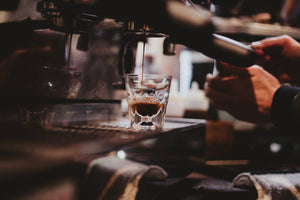Do you ever think that coffee has become rather complicated?
There's little doubt that the emergence of cold brews, iced coffees and no end of dessert-in-a-cup concoctions are a world away from your simple mug of caffeinated comfort!
However, if you love the classic taste of robust, bold coffee beans, perfectly encased in a rich hot brew, you're probably after filter coffee or an intense espresso.
In this guide, the Hoxton Coffee team explains the difference to help you order with confidence or start making those awesome flavours in your very own kitchen.

What is an Espresso Coffee?
Order a coffee (un caffè, per favore) in Italy, and you will get the teeniest, cutest mug you've ever seen, with a powerful, super-strong shot of espresso.
That's a contrast to the conventional coffee in the UK, where you'll get a cup of black filter coffee unless you've asked for something else - and with good reason.
Espresso is the go-to in Italian coffee, and it means, simply, express; delivering a jolt of caffeine with zero frills.
There are countless secret recipes to incredible espressos.
Still, in essence, it's brewed with extremely hot pressurised water, pushed through a finely ground bean, so it is a lot denser than a filter coffee.

How is a Filter or Pour-Over Coffee Different From an Espresso?
The concept is the same - get some excellent quality beans, grind them up, and throw in some hot water to get your drink.
However, filter coffee doesn't use pressurised water but lets the hot water run through the coffee more slowly, usually with a filter to catch the grounds before reaching the cup.
Brewing takes a bit longer, but you end up with a less aggressive cup and can make a whole jug in one go.
That doesn't mean that filter coffee is the poor cousin since it can be a lot more palatable, with less acidity and more delicate coffee flavours.
- Want a serious kick to start your day? Knock back an espresso.
- Prefer to relax and relish your morning coffee? Get the filter pot brewing.
If you prefer a specialist brew or a sustainably sourced coffee with unique accents, a filter cup is a good call since you get all those aromas that are drowned out in an espresso.
Breaking Down the Anatomy of a Humble Espresso
Although your espresso looks like a madly invigorated, concentrated coffee, it's actually quite complex and has several layers.
The crema is that golden coloured top layer, which contains a stack of by-products from the amino acids and sugar in the beans - here you get oils, protein and melanoidins.
That last element isn't anything strange but is natural, healthy and found in many foods, providing antimicrobial, anti-inflammatory and prebiotic benefits.
Now, some people don't like the bitterness of a crema layer, and not all beans will produce this, but it's a signature espresso feature and a sign of a quality coffee that hasn't been stripped of its natural properties.
The liquid underneath forms the bulk of your miniature coffee. The body is the middle proportion, normally a caramel colour, and the heart, or base, is the coffee at the bottom and the darkest part of the shot.

How Long Does it Take to Make an Espresso or Filter Coffee?
Time is one of our most precious resources, and we get that you might not have extra hours to spend making coffee at home before the workday rush!
Filter coffee does take longer than espresso, but it's not exactly laborious.
You should wet the filter and coffee grounds for about 30 seconds - this little touch releases CO2 and means the water will flow through better.
Then, depending on the type of pour-over mug or coffee maker you have, you wait a few minutes for the water to filter through and then get stuck in.
Speedy espressos are a lot quicker, and it should take about 30 seconds max.
Of course, having exceptional coffee and pre-ground beans will get you going sooner if you're in a hurry.
Do I Need Specialist Brewing Equipment to Make Coffee at Home?
There are thousands of retailers and outlets where you can buy basic coffee equipment.
If you're a connoisseur, you can invest in pro tools to make amazing coffee - and an espresso machine is also a great idea if you're new to homebrews and want a fool proof solution!
If you're filtering coffee, you need:
- A dripper or filter machine
- Filter paper
- A cup
Simple as it gets! You can get into it with scales to measure your perfect bean ratio or a thermometer to ensure the water is at an optimal temperature, but it's far from crucial.
There are options like this Pour Over Coffee Dripper for less than £25, or you might want a fancy kitchen statement such as a full-on filter machine - check out the Bravilor Coffee Machine for a whisper under £290.
Espresso machines are equally variable, and you can spend thousands if you want commercial-grade equipment - the more rugged your espresso machine, the more pressure you'll get per cup.
A traditional Sage Barista Espresso Machine will set you back almost £600.
Contenders like the Swan Nordic One Touch Espresso Machine are a tad more affordable (this one comes in at £145).
The Battle of the Better Coffee: Filter vs Espresso
We've said it once if we've said it a thousand times - if you have a great coffee, it doesn't matter how you like to drink it.
Espressos are a craft and can be a fast track way to coffee heaven with the ultimate punch and more intricacy in the layers than many realise.
Try swirling in some milk smoothly to get a new sweet profile, or take your espresso raw and muscular.
Filter coffee is more nuanced, and there’s little better than waking up to the smell of gently brewing beans, perfectly timed to produce a smoother cup.
That's the beauty of premium coffee - there's something for everyone, no matter your taste.

